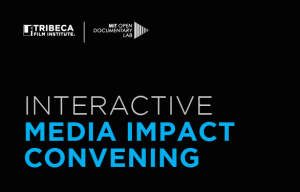On October 30, creative minds came together in New York City to explore “more clarity on what would be an optimal resource for interactive creators.” Ingrid Kopp, director of Interactive at the Tribeca Film Institute, convened creators and thinkers for a day long discussion on understanding impact through interactive media (in partnership with the MIT Open Documentary Lab and supported by the Fledgling Fund).
October 30, creative minds came together in New York City to explore “more clarity on what would be an optimal resource for interactive creators.” Ingrid Kopp, director of Interactive at the Tribeca Film Institute, convened creators and thinkers for a day long discussion on understanding impact through interactive media (in partnership with the MIT Open Documentary Lab and supported by the Fledgling Fund).
Kopp emphasized in an introduction the need to consider the many working definitions of “interactive” for the field along with nurturing connections, collaborations and community. An in-person day of discussion isn’t the only route. For the last few weeks, TFI and the MIT Open Documentary Lab have been hosting a working group via conference call tackling taxonomies, funding, sustainability, measurement and more. But sometimes a face to face conversation can renew energy and foster new connections.
The Interactive Media Impact Convening achieved this by gathering some of the most active media makers and producers in one room. The organizers also made use of an expert facilitator to maximize production and time.
We had a total of five working hours when you take into account breaks and transitions. And in that amount of time we weren’t going to determine the ultimate definition of interactive media, or solve all of the problems facing creators. But we started to unpack major themes.
Listening
Leaders in the field providing moments of inspiration and thought throughout the day: a welcome from Sheila Leddy, a Skype call with Wendy Levy, a review of resources with Jessica Clark, perspectives on risk and ethics in video activism from Sam Gregory. And interactive creators who have takent he plunge gave us a deeper dive into individual projects:
- Question Bridge: http://questionbridge.com/
- Hollow: http://hollowdocumentary.com/
- Fort McMoney: http://www.fortmcmoney.com/#/fortmcmoney
- Sandy Storyline (work in progress): http://www.sandystoryline.com/
- Priya’s Shakti (work in progress): http://www.priyashakti.com/
- The Enemy (work in progress): @theenemyishere
Doing
After listening, our task was to brainstorm about those optimal resources. In breakout groups we asked what would be useful for the community moving forward. The results were practical, ambitious and comical, and not without common themes.
The Ideas:
The MOOC That Saved the World
– an interactive documentary course
Makers & Movements
– a resource to encourage code sign with creators and social movements to address relationship gaps
The Optimus Prime
– an interactive and online space for exploring collaboration, standards, and ethics
Oops! I did it again!
– a social platform for sharing mistakes and tips, with tags specific to emotions and media categories
Logbook
– an Evernote time-machine, a journal and archive for recording the progress and milestones on a project that can be pulled into a final report for funders or public sharing
The Takeaways
- We need to support research professionals to work alongside the creative team.
- The need for honest accountability and collaboration doesn’t change.
- Everything has an impact is not an adequate statement in the documentary world.
- Sharing failures is good for the community.
- Creators want to do more sharing: sharing learning, sharing resources, sharing language.
The Interactive Media Impact Convening proved that the community in this field share a desire to strengthen the capacity for makers; hopefully funders will take note.
More Resources
- Assessing the Social Impact of Issues-Focused Documentaries: Research Methods & Future Considerations: https://cmsimpact.org/media-impact/related-materials/documents/assess…
- Measuring Media Impact: An Overview of the Field (PDF):http://www.learcenter.org/pdf/measuringmedia.pdf
- The Impact Field Guide & Toolkit: http://impactguide.org/
- Even more impact resources and models: http://mediaimpactfunders.org/assessing-impact-of-media/
